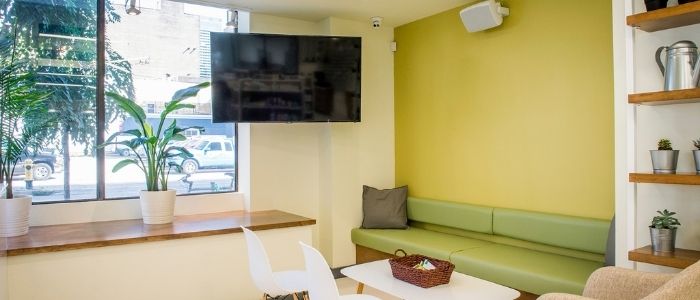Constructing a medical clinic in Canada is a substantial undertaking that requires meticulous planning and financial prudence. From choosing the ideal location to making strategic design decisions, there are various approaches you can employ to manage medical clinic construction costs effectively. This article will delve into the key cost-influencing factors and provide actionable insights to help you create a cost-efficient clinic without compromising quality.
Table of content:
- 1. Factors Contribute to the Medical Clinic Construction Costs
- 2. Strategies to Lower the Construction Costs
- 3. 5 Steps to Medical Clinic Construction
- 4. Modular medical clinics
- 5. Other Factors involved in Medical Clinic Construction Costs

Understand the factors that contribute to the variance in medical clinic construction costs
Location
The geographic location plays a pivotal role in cost variations. Urban areas typically entail higher land and labor expenses, while rural locations may offer more budget-friendly alternatives.
Size and Scope
The dimensions and scope of the clinic, including the number of examination rooms, waiting areas, and specialized facilities, significantly impact overall costs. Larger clinics generally require more materials and labor.
Design Complexity
The intricacy of the clinic’s design and architectural features can also influence costs. While an innovative design can enhance the clinic’s appeal, a simpler design can lead to cost savings.
Material Selection
The choice of construction materials, finishes, and fixtures plays a vital role in determining expenses. Opting for durable yet cost-effective materials strikes a balance between quality and affordability.
Regulations and Permits
Complying with local building codes and obtaining necessary permits adds to the cost. However, adherence to regulations is vital for ensuring a safe and legally compliant clinic.
Strategies to Lower the Construction Costs
Careful Site Selection
Opt for a location that balances accessibility, visibility, and cost-effectiveness. While urban areas offer convenience, they may be more expensive, whereas suburban or less developed areas could be more affordable.
Functional Design
Prioritize functionality over extravagance. A well-organized layout that optimizes space usage and flow can significantly reduce unnecessary construction expenses.
Optimize Space
Efficiently using square footage can lead to substantial savings. Incorporating multi-purpose rooms and flexible spaces can accommodate various functions, thus reducing the need for additional rooms.
Standardized Layouts
Implement standardized room layouts to streamline construction and minimize design complexities. This approach can also expedite the construction process, saving time and money.
Energy Efficiency
Integrate energy-efficient systems and materials. Although there might be upfront costs, energy savings over the long term can offset the initial expenditures.
Bulk Material Purchase
If constructing multiple clinics, consider bulk purchasing materials, fixtures, and finishes. This approach can lead to volume discounts and lower overall costs.
Value Engineering
Collaborate with architects and contractors to explore cost-saving alternatives while maintaining quality. Value engineering involves finding innovative solutions that provide the desired functionality at a lower cost.
Competitive Bidding
Obtain bids from multiple contractors to ensure competitive pricing. However, exercise caution to avoid compromising quality for the sake of lower costs.
Phased Construction
If budget constraints are a concern, contemplate phasing the construction process. This approach allows you to build essential areas first and expand later as finances permit.
Project Management
Effective project management is pivotal for cost control. Monitor progress, address issues promptly, and avoid unnecessary delays that can inflate expenses.
Collaboration with Professionals
Partner with experienced architects, contractors, and consultants specializing in medical facility construction. Their expertise can guide you in making informed decisions aligned with your budget.

Opening a medical clinic is a noble and supportive investment to make in your community. But taking that ambition through an entire construction process up to the point where the building is ready to open its doors is a long process that requires a lot of planning, plenty of investments, and the right group of construction experts to get the job done.
Hard working families rely on local medical clinics to keep their children healthy and their homes in good standing. Local clinics are even more important in today’s environment due to the coronavirus pandemic. The closer that families can remain near home for urgent medical care, the better for their own health. This extend to the health of their friends and neighbours as well.
Medical Office Building Construction Turnkey Service & Projects
Medical Office Contractor / New Medical Office Construction Projects
5 Steps to Medical Clinic Construction
Begin work on your medical clinic using the same practices as any new development: follow the commercial construction step by step guide. Once you have your development process mapped out, you can start to calculate the true costs of your work.
Step 1. Planning
No project can move forward without a plan that has a solid foundation. The planning phase is when you scout for the right location and undertake environmental assessments. From here, you will apply for the appropriate zoning permits. You will then assemble a team of visionaries to help you turn your plans for a medical clinic into a fully functional building.
Step 2. Design
With a location selected, and a team of leaders, including an architect, officially on the job, the design work can begin. Your architect will take your vision and translate it into a complete building spec that showcases how the building will look once construction is finished.
Step 3. Pre-construction
Once you have the designs finalized, the pre-construction phase can begin. This is when you and your team of architects, construction supervisors, project managers, commercial managers, and more start to forecast the true costs to build the medical clinic. Those forecasts will direct how to shape the budget for the entire project.
Step 4. Procurement
With the budgets are set, it’s time to assemble all of the materials that will be used to construct the building. Since you have the master budget complete and categorized, your commercial manager will negotiate the best possible deals for all of the construction materials in an effort to keep costs in line and under budget.
Step 5. Construction
All of the crews are assembled; the designs are approved, the budgets are finalized, and the materials are assembled onsite. Now it’s time for the construction work to begin.

Modular medical clinics
With space in hospitals and healthcare services becoming increasingly strained due to the coronavirus pandemic, modular medical clinics are in rising demand. You can achieve your goal of building a medical clinic for the community much faster and cheaper using modular construction practices, enabling the surrounding neighbourhoods to become more healthy and more secure.
Using modular construction, the materials used to build the clinic are assembled in a warehouse offsite from the selected location for your building. Modern technology has allowed construction workers to create standardized modules that align with the building specifications in architectural blueprints. Once the work on each module is complete, the pieces will ship to the site of your medical clinic. Here, they will connect together to form the basis of your building.
Among the key benefits of modular construction, the most valuable advantage is the time savings in the construction process. Modular construction relies on a harmonious blend of human labour and machines to assemble the building’s various pieces. These components will ship out to the site of the medical clinic. With technology, the construction phase of the entire development process reaches completion in a fraction of the time than traditional construction.
Other factors involved in medical clinic construction costs
As the structure of the building comes together, work must begin on how to install all of the amenities that will power the medical clinic once its doors are open to the public. Treating patients requires electricity, gas, water, and sanitation. It is the only way to ensure people walk out of the clinic feeling healthier than they did when they walked in.
Electrical work
Any home or business needs electricity to be functional for the people that will dwell inside. Installing the wires and power outlets ensures power can flow through the clinic and keeps the business up and running. Hire a proven electrician from a talented pool of contractors and subcontractors to get electricity flowing into your clinic.
Gas
Like electricity, gas is necessary to power the medical clinic. Installing gas lines is vital but sensitive work that requires a steady hand to properly finish the job. Make sure you hire the best to appropriately hook up the gas line.
Sanitation
Any building, commercial or residential, needs good plumbing to flush away unwanted waste and sanitation. A capable plumber will ensure that your medical clinic has fresh water flowing into the taps and sanitary waste flowing out into the sewers.
Ventilation
Fresh air must circulate through the building to keep everyone inside healthy, especially now in the age of COVID-19. A good ventilation system should have the option to easily turn on and off both air conditioning as well as heat to keep the clinic comfortable for both patients and employees.
Airlocks
Given that a medical clinic should have areas that are isolated and sterilized for the health and wellbeing of both patients and employees, it makes sense to install airlocks that secure areas of the clinic where more serious medical care is administered.
Storage
Medical clinics need plenty of supplies, including syringes, gauze, and personal protective equipment. Ensure that you factor storage space into your designs for the clinic so that there is room onsite to store additional supplies and equipment that will keep the clinic fully functional.

In conclusion
Constructing a medical clinic in Canada requires comprehensively considering factors that influence costs. You can attain a cost-effective medical clinic without compromising quality by adopting strategic approaches such as judicious site selection, functional design, energy efficiency, and collaboration with experienced professionals. Balancing your vision with fiscal prudence will result in a clinic that serves the community’s healthcare needs while showcasing your commitment to providing accessible and efficient healthcare services.
At BUILD IT, we manage the team of developers on your behalf so that you can spend more time focusing on how to grow and scale the business. Get in touch with the experts at (905) 696-0486 or email [email protected] for more details.
